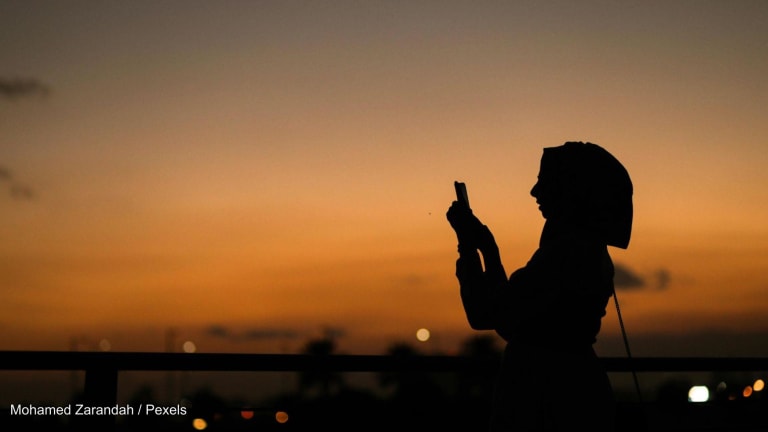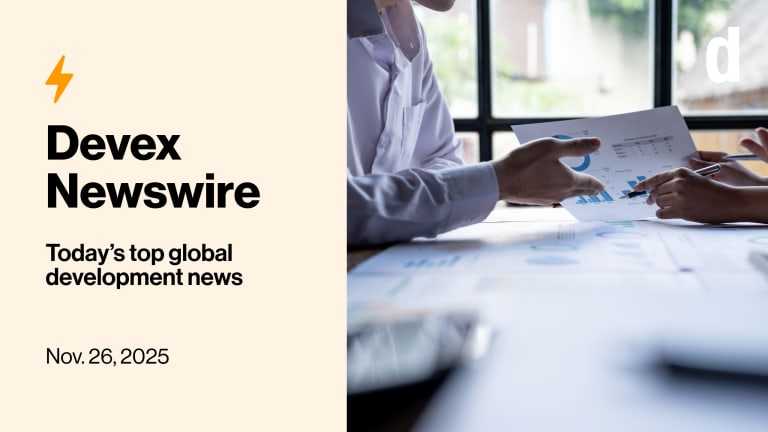USAID unveils a new digital policy to drive the next decade
USAID's new digital policy aims to bridge the global digital divide, fight misinformation, and leverage AI for development — a 10-year plan that comes with a $14.6 million boost.
The U.S. Agency for International Development has released its new digital policy — a road map that will guide the institution's approach to digital technology over the next 10 years. “It’s clear we stand at the cusp of another technological upheaval that none of us really can predict,” said USAID Administrator Samantha Power at the policy’s launch event last week. “Since we know that we can't stop the march of technology, maybe it's tempting to sit back and hope for the best to disappear, in fact, into our technology. But, needless to say, we can't do that. We need to take action, we need to be intentional.” The agency’s new digital policy is trying to do just that. In 47 pages, USAID outlines how it will both use and combat artificial intelligence over the next decade, focusing on three main objectives: furthering digital connectivity, protecting the world from technology’s harms, and embracing digital tools for human progress. A new, independent office is being created to help the agency see those objectives through, and $14.6 million in new funding will be channeled through USAID to do the same. “Development is digital,” Power said. “If we come together to extend the reach of foundational technology across the planet, to put the safeguards in place to manage potential harms, and to deploy technology to take on humanity's greatest challenges, then technology can, in fact, play a role in making the world a better place for people everywhere.” Expanding the digital footprint The digital space isn’t new for USAID. At the launch event, Power spoke about a number of digital-first programs the agency had already implemented. M-mama was one of those examples — a mobile application that connects pregnant women with volunteer drivers who can provide a ride to the hospital in the case of an emergency. As of last week, the application had gotten women and babies the care they needed in 100,000 emergencies, Power said — and in the Tanzanian region where m-mama was piloted, maternal and newborn mortality fell by nearly 40% in just four years. Still, Power highlighted that there were still 2.6 billion people left unconnected to the internet, the majority of whom are women. Today, the administrator said women’s exclusion from the digital world has cost the global economy $1 trillion dollars. “If we don't solve these fundamental gaps, then as we increasingly use tech to drive development progress, we will paradoxically be exacerbating inequalities,” Power said. To close that gap, USAID is currently conducting “digital ecosystem country assessments'' in countries across the world. It’s part of an initiative that aims to bring both U.S. funding and private sector investment to boost countries’ digital infrastructure — an attempt to get ahead of the Russian and Chinese investments to do the same. “When some nations have the technological services that can attract business and investment and others simply do not, then the nations that need the growth and development that technology can bring those that need them the most are shut out from it,” said Power. “And they are more likely to turn to other partners like Russia or the [People’s Republic of China] to support their digital transformations — and those countries are very eager to step in, unfortunately, without a commitment to safeguarding privacy, sovereignty, or human rights.” A few hours after the launch event, Power said USAID would be signing agreements with the governments of Estonia and Latvia — which both share a border with Russia — to help nations across Eastern Europe, Central Asia, and Africa boost their digital capabilities. Digital diplomacy Russia and China’s influence on the digital world are noted within the policy, too, with the document stating both countries are using their influence and technological prowess to “create more permissive conditions for repressive and authoritarian practices,” including censorship, mass surveillance, and information manipulation. A USAID program in Indonesia, for example, unearthed a “Chinese bot network” that was using female, Western-sounding usernames to promote a positive narrative about the treatment of Uighurs in Xinjiang province. The tool alerted the social media platforms, which resulted in the removal of posts, according to the USAID policy. “It just goes to show just as the capacity for technology to manipulate information is accelerating, so too in fact, can the capacity for technology to detect that manipulation,” said Power, speaking at the launch event. Still, Power said China had also provided facial recognition software to at least 80 other nations, “enabling mass surveillance and targeted repression of dissidents and activists.” “Many tech capabilities are growing faster than our ability to fully understand them, never mind to manage the potential harms,” Power said. “And our growing reliance on technologies make the consequences when they fail catastrophic.” Digital from the get-go Despite the risks, USAID’s digital policy also emphasizes the opportunities. From an artificial intelligence tool in India that is listening to patients’ coughs and analyzing them for tuberculosis, to an application that now connects Ukranians to 120 key government services through their phones, the agency has already bought into several digitally focused development programs. The policy outlines how that work will expand in the years to come, in part, by doubling the previous $15 million budget of USAID’s technology division. Country missions, country offices, and regional bureaus must also hire either a digital development adviser or a digital specialist within the next 18 months. That staff member will spend the majority of their time working on digital and cybersecurity programming. And, every member of the agency will be required to complete a training course on the digital policy itself. “We know that as technological capabilities expand, and as the reach of technologies increase across the planet, opportunities to use emerging technologies to take on humanity's greatest challenges will only grow,” said Power. “But, to take advantage of this moment, we need to be prepared, we need to have the right tools at the ready to jump at the opportunities, and we need to take on the risks.” In seven years, Power said she expects any request for proposals — whether they are for projects focusing on education, the environment, or agriculture — to have a digital component “built in as a design feature from the beginning.” It follows suit with another document released by USAID earlier this month: the agency’s democracy, human rights, and governance policy, which included a focus on digital democracy and an emphasis on countering digital repression. “The actions we take now will determine whether this next age of technological advances will bring more inequality, exploitation, subjugation — or whether it will connect more people across the world to essential services, to economic opportunities, and to each other,” Power said.
The U.S. Agency for International Development has released its new digital policy — a road map that will guide the institution's approach to digital technology over the next 10 years.
“It’s clear we stand at the cusp of another technological upheaval that none of us really can predict,” said USAID Administrator Samantha Power at the policy’s launch event last week. “Since we know that we can't stop the march of technology, maybe it's tempting to sit back and hope for the best to disappear, in fact, into our technology. But, needless to say, we can't do that. We need to take action, we need to be intentional.”
The agency’s new digital policy is trying to do just that. In 47 pages, USAID outlines how it will both use and combat artificial intelligence over the next decade, focusing on three main objectives: furthering digital connectivity, protecting the world from technology’s harms, and embracing digital tools for human progress.
This story is forDevex Promembers
Unlock this story now with a 15-day free trial of Devex Pro.
With a Devex Pro subscription you'll get access to deeper analysis and exclusive insights from our reporters and analysts.
Start my free trialRequest a group subscription Printing articles to share with others is a breach of our terms and conditions and copyright policy. Please use the sharing options on the left side of the article. Devex Pro members may share up to 10 articles per month using the Pro share tool ( ).
Elissa Miolene reports on USAID and the U.S. government at Devex. She previously covered education at The San Jose Mercury News, and has written for outlets like The Wall Street Journal, San Francisco Chronicle, Washingtonian magazine, among others. Before shifting to journalism, Elissa led communications for humanitarian agencies in the United States, East Africa, and South Asia.








